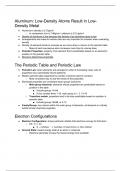Class notes
CHEM 130 Chapter 3: Periodic Properties of Elements
- Course
- Institution
Class notes for Chapter 3: The Periodic Properties of Elements in the class General Chemistry: Macroscopic Investigations and Reaction Principles (CHEM 130) at the University of Michigan. Topics covered include the periodic table, electron spin and configuration, Coulomb's law, orbitals, ionization...
[Show more]



